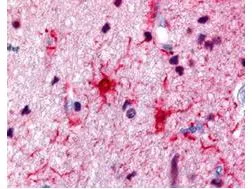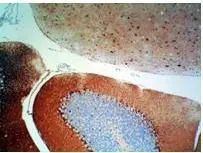
GTX48819 IHC-P Image
S100 antibody

GTX48819
ApplicationsWestern Blot, ELISA, ImmunoHistoChemistry, ImmunoHistoChemistry Paraffin
Product group Antibodies
ReactivityBovine, Human, Mouse, Rat
TargetLOC104968698
Overview
- SupplierGeneTex
- Product NameS100 antibody
- Delivery Days Customer10
- ApplicationsWestern Blot, ELISA, ImmunoHistoChemistry, ImmunoHistoChemistry Paraffin
- CertificationResearch Use Only
- ClonalityPolyclonal
- Concentration5 mg/ml
- Gene ID104968698
- Target nameLOC104968698
- Target descriptionprotein S100-A1
- HostRabbit
- IsotypeIgG
- Scientific DescriptionS-100 protein derived from brain tissue is an acidic calcium-binding protein with molecular weight of about 21kDa. In human brain tissue S-100 protein is mainly presented as two isoforms - bb homodimer (S-100b) and ab heterodimer (S-100a). Because of its predominant location in astroglial cells S-100 protein can be used as a sensitive and reliable marker for central nervous system injury. Structural damage of glial cells causes leakage of S-100 protein into the extracellular matrix and into cerebrospinal fluid, further releasing into the bloodstream. Measurements of S-100 protein in patient serum samples are useful in monitoring of traumatic brain injury, ischemic brain damage after circulatory arrests, and in diagnosis and prognosis of clinical outcome in acute stroke. Although predominant among the water-soluble brain proteins, S-100 is also found in a variety of other tissues. S-100 is an intracellular protein that weakly binds calcium. It binds zinc very tightly, however, and this appears to increase the affinity of the protein for calcium. Distinct binding sites, with different affinities, exist for both ions on each monomer. Physiological concentrations of potassium ion antagonize the binding of both divalent cations, especially affecting high-affinity calcium-binding sites.
- ReactivityBovine, Human, Mouse, Rat
- Storage Instruction2°C to 8°C,-20°C
- UNSPSC12352203
References
- Novel electrospun poly(epsilon-caprolactone)/type I collagen nanofiber conduits for repair of peripheral nerve injury. Yen CM et al., 2019 Sep, Neural Regen ResRead more


